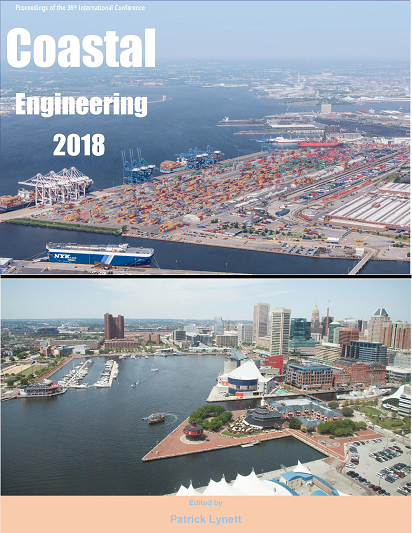Abstract
Sliding force and punching pressure were contributing factors to widespread breakwater damage caused during the 2011 Great East Japan Tsunami (Takagi and Bricker, 2015), and were dominant factors causing displacement of caissons from the world's deepest breakwater: the Kamaishi bay-mouth composite tsunami breakwater (Arikawa et al., 2012; Bricker et al., 2013). The current study focuses on understanding the physics necessary to correctly model the problem of breakwater over-topping by tsunami. To effectively model the physical behavior of the system, scaled model studies were carried out by Mudiyanselage (2017). The earlier numerical investigations carried out by Bricker et al. (2013) and Mudiyanselage (2017), did not prove conclusive to numerically model tsunami breakwater overflow using OpenFOAM employing a 2-D modeling approach. This was shown to be a major hurdle in prediction of the sliding force on the caisson due to the inability of modeling the non-aerated overflow jet over the caisson. Validation of the numerical model would allow parametric study of the flow physics for varying overflow conditions. As a result, a threefold approach of experimental model, analytical model, and numerical model studies was proposed. To achieve sufficient reliability and have complete flexibility, OpenFOAM was chosen for the numerical setup. This numerical model was used to validate the experiments carried out by Mudiyanselage (2017). The numerical model validates and reproduces the flow physics very well. Overall, the numerical results indicate that non-aeration could provide about 8-19% additional force. It was observed that the force on the caisson has a periodic fluctuating behavior. Additionally, the aeration mechanism and overflow jet breakup during the flow was also investigated. It was observed that the highly 3-dimensional behavior of the overflow jet results in the aeration of the cavity underneath the jet. This also explains why the previous studies Bricker et al. (2013) and Mudiyanselage (2017) failed to correctly model the overflow jet using a 2-D modeling approach.References
M. Abdalla and M. Shamaa. Experimental investigations of nappe profile and pool depth for broad crested weirs. International Journal of Engineering Research and General Science, 4(1), 2016.
T. Arikawa, M. Sato, K. Shimosako, T. Tomita, D. Tatsumi, G.-S. Yeom, and K. Takahashi. Investigation of the failure mechanism of the kamaishi breakwater due to tsunami, initial report focusing on hydraulic characteristics. Technical note of the Port and Airport Research Institute, 2012.
J. Bricker, H. Takagi, and J. Mitsui. Turbulence model e ects on vof analysis of breakwater overtopping during the 2011 great east japan tsunami. Proceedings of the 2013 IAHR World Congress, 10153, 2013.
H. Chanson. Air Bubble Entrainment in Free-Surface Turbulent Shear Flows. Academic Press, 1996.
V. T. Chow. Open Channel Hydraulics. Blackburn Press, 2009.
S. S. Deshpande, L. Anumolu, and M. F. Trujillo. Evaluating the performance of the two-phase flow solver interfoam. Computational Science and Discovery, 5(1):014016, 2012. URL http://stacks.iop. org/1749-4699/5/i=1/a=014016.
P. Higuera, J. L. Lara, and I. J. Losada. Simulating coastal engineering processes with openfoam. Coastal Engineering, 71:119 - 134, 2013. ISSN 0378-3839. doi: https://doi.org/10.1016/j.coastaleng.2012.06. 002. URL http://www.sciencedirect.com/science/article/pii/S0378383912001093.
B. E. Launder and D. B. Spalding. The numerical computation of turbulent flows. Computational methods in Applied Mechanics and Engineeering, 3-2:269-289, 1974.
P. M. B. Lopes. Free-surface flow interface and air-entrainment modelling using openfoam. 2013. [Accessed Online], "https://estudogeral.uc.pt/bitstream/10316/24534/1/Pedro%20Lopes_ %20Free-surface%20flow%20interface%20and%20air-entrainment%20modelling%20using% 20OpenFOAM_FINAL.pdf".
J. Mitsui, A. Matsumoto, M. Hanzawa, and K. Nadaoka. Stability of armor units covering rubble mound of composite breakwaters against a steady overflow of tsunami. Coastal Engineering Proceedings, 28, 2014.
S. Mudiyanselage. E ect of nappe non-aeration on caisson sliding force during tsunami breakwater overtopping, 2017. [Online], "https://repository.tudelft.nl/islandora/object/uuid: 728416ce-fa4e-4459-ac56-2059b2fc10c3?collection=education". OpenCFD. Extended code guide. https://www.openfoam.com/documentation/cpp-guide/html/ index.html, 2018.
A. Patil. Numerical investigation of the e ect of nappe non-aeration on caisson sliding force during tsunami breakwater over-topping using openfoam. TU Delft repository, student theses, 2018. [Online], "https://repository.tudelft.nl/islandora/object/uuid% 3A65aff400-8610-4867-92fa-ca33a9e54a01?collection=education".
J. Peakall and J. Warburton. Surface tension in small hydraulic river models-the significance of the weber number. Journal of Hydrology, New Zeland, 35, 1996.
J. Spurk and N. Aksel. Fluid Mechanics. Springer, 2008. doi: 10.1007/978-3-540-73537-3.
A. Suppasri, P. Latcharote, J. D. Bricker, N. Leelawat, A. Hayashi, KeiYamashita, F. Makinoshima, V. Roeber, and F. Imamura. Improvement of tsunami countermeasures based on lessons from the 2011 great east japan earthquake and tsunamiâ†situation after five years. Coastal Engineering, 58(04):1640011., 2018.
H. Takagi and J. Bricker. Breakwater damage and the e ect of breakwaters on mitigation of inundation extent during tsunami's: Case study of the 2011 great east japan earthquake and tsunami. Handbook of Coastal Disaster Mitigation for Engineers and Planners, pages 363-383, 2015.
H. Takahashi, S. Sassaa, Y. Morikawaa, D. Takanoa, and K. Maruyama. Stability of caisson-type breakwater foundation under tsunami-induced seepage. Elsevier journal of Soils and Foundations, 54, 2014.

